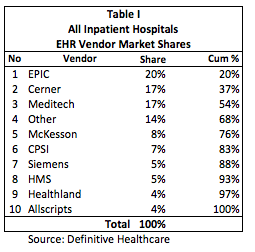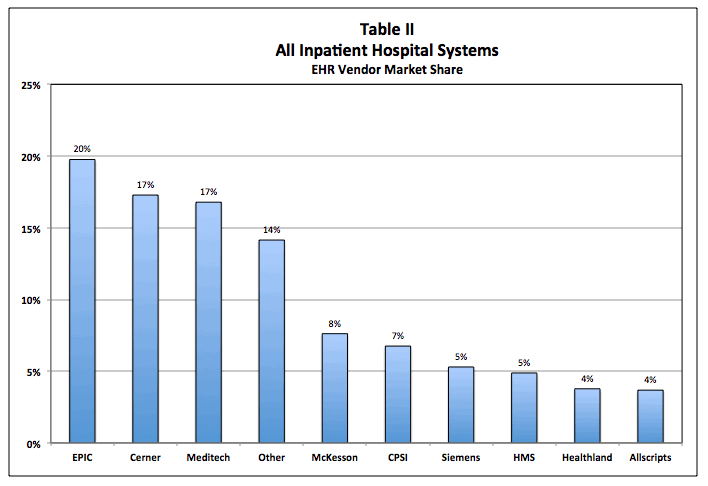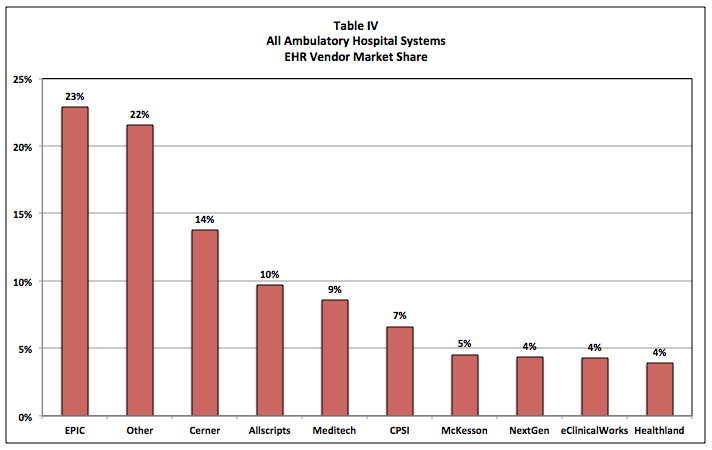We’re always interested in who’s up and who’s down. Whether it’s TV shows, Senate races, book sales or baseball stats, we want to know who’s up, who’s down and who’s going nowhere.
We’re big on trends, shares and who’s going where. The closer the race, the more avid the interest – My Nats would be sitting pretty if only the Braves weren’t so pesky. The EHR market place is no exception for interest, even if the numbers are a lot harder to follow than the National League East.
In my last foray into EMR market share, I looked at SK&A’s stats from their rolling survey of US medical practices.
Another company, Definitive Healthcare similarly tracks the hospital EHR marketplace. They’ve generously shared their findings with Healthcare Scene and I’ve used them here. Please note: Any errors, mistakes or other screw-ups with their numbers are mine alone. With that said, here’s what I’ve found.
How Many Divisions Does the Hospital Market Have?
Definitive divides the hospital market into several categories that can be daunting to follow. That’s not their making. It’s the nature of the market.
The major division that Definitive reports on is inpatient versus ambulatory systems. You might think that ambulatory systems are only for non hospital setting, but hospitals, of course, have many outpatients and use ambulatory EHR systems to serve them.
The Inpatient Marketplace
Among inpatient systems, EPIC leads with a 20 percent share shown in Tables I and II. The market is highly concentrated with EPIC, Cerner and Meditech commanding 54 percent. The remaining 46 percent scatters with no one breaking double digits.


The Ambulatory Hospital Marketplace
The picture for hospital ambulatory systems used is notably different. See Tables III and IV. While EPIC and Cerner vary slightly from their inpatient share, the other vendors shift all over the place. Allscripts barely registers 4 percent in inpatient, jumps to third place with 14 percent.
Siemens and HMS drop off the top ten being replaced by eClinicalWorks and NextGen. At 22 percent is the catchall, Other EHRs. This is up 8 percent from its inpatient 14 percent.
Inpatient EHRs: Health Systems and Independent Hospitals
Definitive also breaks down inpatient hospitals by health system hospitals v independents. Almost a majority of health systems, 47 percent, choose EPIC and Cerner. See Tables V and VI. Indeed, the top four vendors, EPIC, Cerner, Meditech and McKesson astoundingly have a 74 percent share. The other vendors are at 7 percent or less.
Independent hospitals differ a bit from this pattern. Non major vendors have 12 percent and open source Vista has 5 percent, but otherwise the pattern is similar.
Inpatient Hospitals by Size: Under and Over 100 Beds
Hospitals with 100 plus beds, no surprise, favor EPIC, Cerner and Meditech. These three have a monopolistic 64 percent. See Table VII.
Small, Inpatient Hospital Systems: A More Competitive Market
Small hospitals are a different story. The top five vendors are bunched around 14 percent each. See Table VIII. The mix of vendors is starkly different. Meditech and Cerner lead with EPIC third. However, Epic drops nine percent from the prior group to 14 percent in this.
In the prior tables, the top three vendors have a market majority. In this group, 65 percent of the market belongs to the third through tenth vendors. You can see the difference in competition in Tables VIII and IX.
Hospital Ambulatory EHR Systems by Bed Size
The ambulatory market for hospitals with 100 plus beds is similar to the inpatient market. EPIC, Cerner and Allscripts have a 53 percent share.
The remaining share is split among several vendors, with eClinicalWorks, and athenahealth making an appearance. Significantly, Other EHRs ranked second.
Smaller hospitals’ ambulatory systems, as with smaller inpatient hospitals, show a competitive market. The category Other EHRs actually leads with a 21 percent share. Tables X and XI show the difference between these two markets.
Market Shares: What’s the Conclusion?
In this and previous posts, I’ve looked at EHR vendor market shares sliced up in several ways. I’ve used what I consider reliable, independent data sources from SK&A and Definitive Healthcare. I used their information because they are careful to include all practices in their surveys not just those that bother to reply.
I also used them for the simple reason that they were freely available to us. There are other sources, such as KLAS, that produce market surveys, but they charge about $2,500 for their analysis. Moreover, they keep all but the most general findings behind their paywall.
What then is the message from all these numbers? It’s this: there is a competitive market, but it’s only robust among small practices. Those with three or less practioners have the most competitive market with eClinicalWorks in the lead. Within major segments, EPIC, Cerner and Meditech dominate. The non hospital market is more mixed, but EPIC, Cerner, etc., share increases as practice size grows.
For these larger practices, it’s monopolistic competition. If you’re looking for an EHR and you have ten or more docs, you can find any number of vendors. It’s most likely you’ll end up choosing among just a few big guys.
This reminds me of when we shopped for kitchen cabinets and counter tops. We were impressed with some dramatic possibilities. The sales rep, who we got to know well, laughed:
“When folks start out they focus on the avant garde. Then they realize they’re choosing for several years. Suddenly they get more conventional.”
If you come by our place, you’ll see our oak cabinets and white tile counter top. I think it goes that way with hospital execs choosing EHRs. They may toy with something different, but in the end, they’ll go with what they know. After all, no one every got fired for buying EPIC. Well, almost no one.
Next: Attribution and Market Share
If you still haven’t got your fill of market numbers, I have one more topic to explore. I’m interested in knowing how market share relates to MU attestations. That is, does a high market share guarantee a high attestation rate? The next post in this series will look at that.
If you have questions on market share, please post a comment.






















